There’s a reason mom ran you an oatmeal bath when you had childhood skin issues: time and again oats have been proven as gentle and effective for soothing irritated skin.
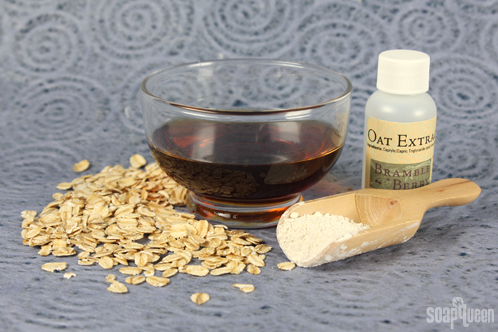
Left to right: rolled oats, Hydrolyzed Oats, Oat Extract, Colloidal Oatmeal
According to CosmeticsInfo.org, an information resource that includes factual, scientific information on ingredients most commonly used in cosmetics and personal care products in the United States, oats can “temporarily protect injured or exposed skin from harmful or annoying stimuli, and may therefore provide relief to the skin.”
Bramble Berry carries several oat related products that can impart nutrients and moisturizing properties to bath & body products. The three main ones are:
Hydrolyzed Oats – This is viscous, dark brown liquid that comes from whole oats. Hydrolyzed oats help skin feel velvety soft, and it’s commonly used in skin or haircare products between 1 – 5%. It is a fantastic addition to lotion recipes.
Oat Extract – This clear liquid is soothing, moisturizing, and ideal for mature skin. It’s also great for baby products too! Use it in lip balms, skincare or hair care products between .5 – 3%.
Colloidal Oatmeal – Colloidal oatmeal is simply super finely-ground whole oats. It’s often used in lotions to create a barrier, making it ideal for super dry skin. It’s also excellent in face masks, milk baths and soaps. Usage rates vary from product to product, so visit the product’s page for exact rates.

Left: Soothing Baking Soda Oatmeal Bar with Oat Extract and Colloidal Oatmeal. Top: Oatmeal Facial Scrub and Mask with Oat Extract. Bottom: Winter Dry Skin Lotion with Hydrolyzed Oats.
You can also add colloidal oatmeal, rolled oats and oat extract to cold process soaps. The Oatmeal Layers recipe in the Soap Crafting book is a soothing bar featuring lots of oat-y goodness. Oats are typically added when the soap batter reaches a thin to medium trace.
Add rolled oats or colloidal oatmeal to melt and pour soap when the soap has cooled to around 120 – 125 degrees F. You want the base to be cool enough that it can “suspend” the oats, otherwise they’ll simply sink or float to the bottom! You can find a variety of melt & pour and cold process recipes featuring oats below:
What are you favorite additives to soothe dry, irritated skin?
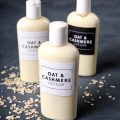
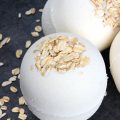
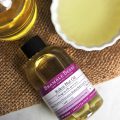
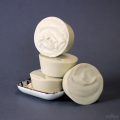
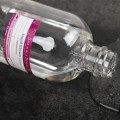
;ast night i spent 3 hours perfecting a dog bar cp. I infused pine into a delicious pine oil which took me all day. Last night i ground up rolled oats and made oatmilk. When i tried to add the lye it turned into a sludge gross mess… so i threw it out and just used water for lye. i figured it would be the same thing when i add it later… well i added an oz to a TOTAL of 31 oz batch. 21 oz of oils total. I used old fashioned rolled oats and when i added and mixed it, immediately it turned to sludge.. i figured maybe its accelerating, so I worked quickly. Well i poured it all and it sucked up all the water and dumped all the oils so it is probably a caustic soap that has not saponified at all..obviously right? I dont know what to do with this batch now. I might throw it out. Did i use too much oats? Did I use the wrong kind? Would steel cut oats still do this? Everyone has such success with oats and i thought i did everything right… all my neem oil was used in that batch too… sigh. =(
Hi Vanessa!
Oh no, I’m sorry about that! In our tests and recipes the old fashioned oats worked just fine in cold process soap, so I’m not sure why that batch was acting up. Can you tell me a bit more about your recipe, including ingredients and temperatures? Thanks so much! 🙂
-Kelsey with Bramble Berry
Hello! I just seen this reply as im trying once more to add oats. Im using, Old Fashioned Rolled Oats and the ingredients say: Whole Grain Oats. From Bobs Red Mill. I bought a new bag. I have learned a lot from that past experience. I had to much castor oil and pine for this particular recipe. So i think thats what happened there >..< im going to attempt to mix my oils and lye around 165? or higher like 170? Im also using hazelnut milk instead of water. So its a little tricky because my milk is frozen & i love to do the milk bath so im not sure if i can even add the milk? Could i heat up the lye solution after its mixed? Or will this result in scorching the milk anyways? Im going to pause this recipe until I have more research and I was hoping to just do it today. My lye finally came in ! LOL By the looks of it i may have to skip the milk =( use water and i might as well use silk then. any advice would be awesome!!! thank you!!
Hey Vanessa!
When working with milk, we recommend freezing it beforehand, then adding the lye slowly. That helps prevent the scorching, which keeps the milk a neutral color and scent. After the lye is all mixed in, it’s usually around 70-80F. For oil temperature, we like to work around 100-120F. That keeps the oils all nice and melted, and isn’t so hot that it heats the lye solution up. 🙂
Read more about working with milk here: http://www.soapqueen.com/bath-and-body-tutorials/tips-and-tricks/how-to-add-lye-to-milk-for-cold-process-soap/
Milk gives your soap a lovely creamy feeling, and works great with the few extra steps of freezing it beforehand! 🙂
-Kelsey with Bramble Berry
I love using oats in my soap, bath and body products! I make an awesome melt and pour soap with oats- I put in rolled oats, goats milk soap base, honey, and olive oil. If I don’t want to have chunky oats in my soap I just boil 1 cup of oats with 3 cups of water, and the water will turn thick and gel like, which you can easily pour into your soap.
-Cadence.
Hi Cadence!
That sounds like an awesome recipe! Nice and soothing. In our tests and recipes, we’ve had the best luck incorporating dry oatmeal. I’m glad boiling the oatmeal works for you! 🙂
-Kelsey with Bramble Berry
I think any discussion about oats used in body care products should include this suggestion: since oats that are processed in the same mills as wheat products are cross contaminated with wheat gluten, and since so many people have wheat gluten allergies, care should be taken to only use oats milled in a gluten free environment. People with celiac disease (extreme intolerance for gluten) are sensitive to its use externally – not just internally. Even the smallest amount of cross contamination can be reacted to by someone who is sensitive.
Hi Irene!
Thanks so much for your suggestion! 🙂
-Kelsey with Bramble Berry
Do you guys have a recipe or recommend any specific recipes for babies with eczema? I made a honey and goats milk(melt and pour) with colloidal oatmeal and 1 tsp honey soap. While it didn’t look very pretty, my husband tested it out and said it left his skin a little dry which defeats the purpose of this bar. Any recommendations?
Hi Crystal!
You may like our Aloe Vera Melt and Pour Base, which is very soothing on the skin.
Also, our Shea Melt and Pour Base is very moisturizing!
Aloe Vera Melt and Pour: https://www.brambleberry.com/Aloe-Vera-Melt-And-Pour-P3185.aspx
Shea Melt and Pour: https://www.brambleberry.com/Shea-Melt-and-Pour-P3192.aspx
-Kelsey with Bramble Berry
I was curious about the differences in oat products, thanks for the information!! I love Bramble Berry!
Hi Cindi!
There are many different oat products, and unfortunately I’m not very familiar with oat products that are not from Bramble Berry. If you have a specific questions, I would be happy to answer it as well as I can! 🙂
-Amanda with Bramble Berry